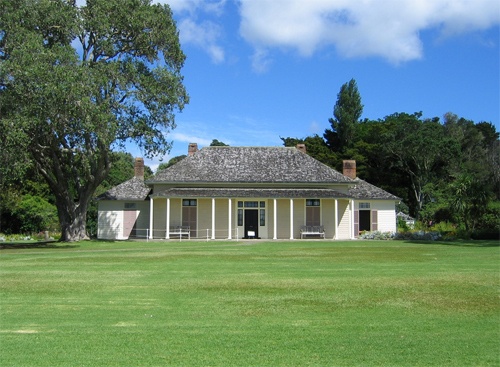
Treaty House (1934)
Treaty site, national monument
On 6 February 1934, 8000 people gathered here to thank Lord and Lady Bledisloe for rescuing this building from neglect. Ironically, the country’s most iconic national monument owes its survival to an English aristocrat.
The house began as a prefab in Sydney, designed by John Verge for James Busby, the British Resident charged in the 1830s with representing British interests in an independent ‘nation’. The New South Wales governor thought Verge’s plan too extravagant and had colonial architect Ambrose Hallen cut it in half.
Although the house had been here for 100 years before the 1934 celebrations, what you see there now says far more about the mid-20th century than it does about 1840. Architects William Gummer and William Page volunteered their services and, as if atoning for Hallen’s surgery, they swamped the humble house with a heavy neo-classical make-up of boxed corners, six-panelled front door, new French doors, classical turned verandah columns with square abacus and plinth and chimney stacks to a new design. The 1933 work produced a structure seven-eighths new. Like Dr Frankenstein’s monster wobbling off the slab, the old Residency, the Busby house, morphed into the Treaty House, the centrepiece of a national shrine, surrounded by all the trappings of nationhood – formal grounds, paths, cannon and flagpoles. Still, there were moments of levity. During the war a curator who delighted in irking true believers in 1840 by pointing out the private parts of Māori carvings to visitors and calling the place ‘the Busby House’, painted the building canary yellow.
Rather late in the day, in the 1970s, the Waitangi National Trust commissioned extensive historical research. Its decision to furnish the building to the period of the 1870s provoked historian Ruth Ross’s resignation. In 1988 it tried again. Clive Lucas’s conservation plan recommended that ‘the house was to be put in touch with 1840, yet the words of 1933 would not be eaten’. Now you see the historic skillion presented in gutted form, protected by a new covered walkway at the rear of the building. Backlit interpretation plinths tell the story of the surviving original fabric, exposed to public viewing. Like the document associated with the site, Bledisloe’s gift remains controversial. As Keith Stewart lamented in 1990, externally ‘this symbol of nationhood will change little, and it will continue to perpetuate a lie initially fabricated during the 1930s’.
Related place
The nearby Whare Rūnanga (1940) was built at the urging of Sir Āpirana Ngata as the first meeting house to represent all tribes.
Further information
This site is item number 92 on the History of New Zealand in 100 Places list.
On the ground
There is a large interpretation centre and shop near the main entrance to the grounds. Inside, the house’s spaces are fully interpreted and guided tours are offered.
Websites
- Heritage New Zealand List entry
- James Busby biography - Te Ara
- Lord Bledisloe biography - Te Ara
- Treaty of Waitangi – NZ History
- Waitangi Roadside Story (video)
Book
- Peter Shaw, Waitangi, Cosmos Publications, Napier, 1992





Community contributions